Art for Social Change
Exhibition Details
Art for Social Change is an exhibition that uses conceptual art to provide powerful experiences that inspire people to take personal action to create positive change for those facing barriers due to lack of accessibility, inclusion, and other oppressive systems and structures.
When: December 3 to December 10, 2025
Where: Keyano Theatre and Clearwater Campus, 8115 Franklin Avenue, Fort McMurray, Alberta
Operating Hours:
- Self-guided tours are available during Keyano College operating hours.
- Guided tours are hosted at 7 PM every weekday and at 1 PM and 7 PM on weekends. Tours will take approximately 1.5 to 2 hours.
No booking required for guided or self-guided tours in English, except for groups of more than 10 people. Contact culture@rmwb.ca to book for a large group.
- Guided tours are offered in multiple languages to cater to more people!
- Tagalog – Dec 5 at 7 PM
- Somali – Dec 7 at 1 PM
- Arabic – Dec 8 at 7 PM
- French – Dec 9 at 7 PM
Book a tour indicating your preferred language at culture@rmwb.ca
Information table and exhibits will be attended on Weekdays (Mon-Fri) from 3 PM to 9 PM and on Weekends (Sat & Sun) from 12 PM to 8 PM.
Contact culture@rmwb.ca if you have any questions!
Disclaimer: We’ve designed this exhibition to include people of all abilities. Some barriers are part of the experience. Need help or have concerns? Contact rmwb.ca/pulse | 780-743-7000.
Program Overview
Art for Social Change is a program that uses conceptual art to provide powerful experiences that inspire people to take personal action to create positive change for those facing barriers due to lack of accessibility, inclusion, and other oppressive systems and structures.
This year, seven (7) multidisciplinary artists have been invited to create installations related to the theme of Accessibility. Their artworks are on display at Keyano Theatre and College from December 3 (International Day for Persons with Disabilities) until December 10 (International Human Rights Day).
Artists have partnered with national and local social profit organizations to deepen their understanding of barriers to access, be it physical, mental, neurological, cultural, or otherwise. The goal of this partnership is not only to bring local context to the artwork, but also to show that support exists and we are all on a journey to find solutions.
Exhibiting Artists
The Art for Social Change program was initiated by the Public Art Committee and the Regional Advisory Committee on Inclusion, Diversity and Equity and is brought to you by the Regional Municipality of Wood Buffalo in collaboration with Keyano College.
Projects
A Barrier to Belonging

A Barrier to Belonging is a photo-based exhibition that aims to illuminate the often non-binary individuals in Canada in their pursuit of gender-affirming care.
Accessibility, or the lack thereof, is a pervasive issue that affects various aspects of life. For Black trans and non-binary individuals, accessing gender-affirming care is fraught with numerous obstacles, both medical and non-medical. These barriers are not just physical but are deeply rooted in social, economic, and cultural dimensions.
In expanding this work, a zine was created to highlight the voices, art and words of queer creatives across Canada, a collective act of storytelling, visibility and advocacy.
Click here to view the zine: A Barrier to Belonging
Imani partnered with Wood Buffalo PRIDE to strengthen her message with local context.
Website: wbpride.ca
Take Action
Each small act of inclusion builds a safer, more accessible world for everyone. Here’s how you can take action to effect change.
-
At work: Choose opportunities to mentor or sponsor 2SLGBTQI+ staff, as they often face barriers in the whole employment cycle. Advocate for policies that create safer workplaces. Always assume that people in the room might be part of the 2SLGBTQ+ community or have loved ones who are.
-
At school: Do not fall into peer pressure. If you notice harmful behaviours, do not ignore it. Safely challenge it and support the person being harmed.
-
In your community: Support Wood Buffalo PRIDE. This can be done by attending their public education sessions, volunteering, or simply attending their events with an open mind.
-
At home: Create affirming spaces by celebrating self-expression. Identify your own biases, keep them at check, and challenge negative behaviours that might result from biases. Take a Test (harvard.edu)
For more tools on how to take action, visit the resources section at wbpride.ca
Imani Edwards (she/her)
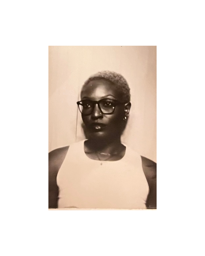
Imani Edwards is a visionary Art Director and Photographer whose work intentionally weaves the threads of storytelling and visual art. Imani’s artistic journey is profoundly influenced by the vibrant tapestry of her community.
Imani’s photography, celebrated in magazine publications throughout Toronto, is a testament to her ability to capture the nuanced layers of human experience that we call life. Her series delves into themes of Black cultural subjects, queerness, and sexuality, offering a compelling narrative that goes beyond the surface to reveal the complex, multifaceted nature of identity.
Driven by a passion for seeing the deeper meaning in every frame, Imani’s work unearths the multitude of experiences that shape our lives. Her lens becomes a conduit for exploring the dynamic interplay of movement and stillness, capturing moments that resonate with profound emotional and cultural significance.
Website: imaniedwards.squarespace.com
Instagram: @imni.edwrds
The Nicest Part of Everyday is You
人间至美在卿身
In this body of work, I invite participants into a space of pure presence—where observation is free from judgment, prediction, or the need for meaning. This practice encourages us to experience each moment as it unfolds, embracing uncertainty and change as essential elements of life and art.
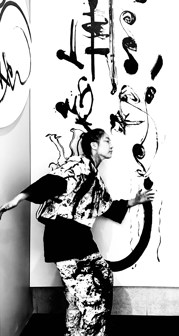
Much like our relationship with a flower or a cat—where we do not impose expectations—we are asked to connect with one another beyond language, culture, or preconceived ideas. This openness fosters authentic relationships rooted in intuition, wisdom, and genuine self-awareness.
Using the art of participatory performance, storytelling, video projection, painting, calligraphy and more, I pose a question: Can we truly see, hear, and understand ourselves and others without the filters of social conditioning? Can we cultivate love and connection from a place of truth, regardless of our backgrounds?
This exhibition is a metaphor for life’s diverse and unpredictable scenes, offering a space to reflect, observe, and flow with presence.
This series of performances are intended to examine two changes of realities within Canadian multicultural landscape:
- Using diverse reinvented language genres to tell and perform fairy tales without direct translation. To invite the audience to follow their inherent wisdom, intuition and sensation of seeing and listening beyond “meaning” and “thinking”.
- Using the fairy tale writing as an experimental literature genre to reinvent the expression of each individual being without using gender pronouns.
Cui’s project has been aligned with the Multicultural Association of Wood Buffalo, which offers services that foster cross-cultural awareness and understanding.
Website: mcawb.org
Take Action
When we practice deep listening, mindfulness, and allow ourselves to truly see one another, we make space for the full spectrum of human expression, a foundation for accessibility and empathy. Here’s how you can take action to effect change.
-
At work: Create spaces where all communication styles are valued, from spoken words to visual, written, or sensory expression.
-
At school: Encourage multilingual and creative storytelling that goes beyond linguistic boundaries.
-
In your community: Engage with the Multicultural Association of Wood Buffalo to learn about cross-cultural understanding and shared storytelling.
-
At home: When someone shares their experience, listen without planning your response. Presence itself is a bridge.
Cui Jinzhe
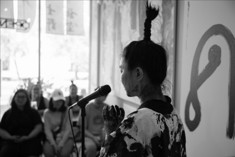
Cui Jinzhe, whose pen name is Qiu Shi, is a painter, poet, and multidisciplinary artist who has been painting, writing and practicing music since her childhood. Jinzhe was born and raised in Dalian, China, where she earned a BA (Visual Communication) at the School of Arts Design from Dalian University of Foreign Languages and an MA (Mixed Media) at Dalian Polytechnic University.
In 2008, Jinzhe moved to Canada to continue her studies and work as an independent artist in Edmonton. Her work explores the integration between Chinese ink painting, calligraphy writing, and interdisciplinary practice, often within an interactive public context.
A yearning for ancient heritage as well as the imagination for the future, Jinzhe’s art practice, everyday life, and inner aspiration are realized and challenged. Her work often evokes awareness, self-reflection, and inner space exploration of the audience.
Website: cuijinzhe.com

Walk A Mile in My Shoes is a deeply personal and participatory installation that challenges viewers to confront the impact of language on identity, belonging, and self-worth. This work explores how seemingly small phrases, whether intended as insults, jokes, or even compliments, can echo through a person’s life, branding them with labels they didn’t choose. Drawing from my own lived experience with bullying and reflection on the power of words, I invite the public to engage with mirrored surfaces etched with phrases contributed by the community. Viewers see themselves reflected in these words – sometimes painfully, sometimes powerfully - and are encouraged to reflect and respond.
This project embodies my belief that art can be a catalyst for introspection, empathy, and change. By visually and emotionally connecting participants with the experiences of others, the installation hopes to foster a moment of pause to inspire more mindful, compassionate communication in a world that often moves too fast to consider the weight of our words.
Share in the experience online @WalkAMileInMyShoes2025
Liana partnered with Girls Inc. of Northern Alberta and the general public to collect content for her project. Girls Inc. of Northern Alberta provides mentorship, programming and services that inspire girls to be strong, smart and bold.
Website: girlsincofnorthernalberta.org
Take Action
Each small act of inclusion builds a safer, more accessible world for everyone. Here’s how you can take action to effect change.
-
At work: Challenge ableist, racist, or gendered jokes. Build a culture of accountability and kindness. Learn here how to de-escalate: De-Escalator-Guide.pdf
-
At school: If you are a parent of a kid who is being bullied, stand up for yourself, your kid or student, not stopping bullying on its tracks has terrible consequences, here are some resources for you. If you are hurting others, it is time to take responsibility, your future might depend on it, here are some steps you can take.
-
In your community: Volunteer or donate to organizations helping youth build confidence and resilience, such as Girls Inc. of Northern Alberta, Big Brothers Big Sisters of Canada; or join the Mayor Advisory Committee on Youth (MCAOY).
-
At home: Teach empathy through storytelling, ask children how words make them feel, and why compassion matters. Be mindful of the words you use at home that might reinforce harmful stereotypes.
If you wish to talk to someone after experiencing this exhibit, here is a list of resources for immediate support: Get Help Now - PREVNet
Liana Wheeldon

Liana Wheeldon is a multidisciplinary artist based in Fort McMurray, Alberta. A graduate of Emily Carr College of Art & Design with a specialization in printmaking, Liana’s artistic practice has evolved to include painting, drawing, built-surface installation, and digital work. Her art is often rooted in the interplay between natural landscapes, pop culture, and personal narrative, infused with both reflection and whimsy.
Liana’s work has been exhibited across Canada and internationally, and can be found in private collections around the world. Recent projects include public art installations for igNIGHT Art Illuminated, a portrait series reflecting on the labels and language used to frame iconic women in popular culture, and her ongoing comic line, Ravenous Comics, featuring her original character Joe Raven. Through both her personal and collaborative work, Liana uses art as a tool for storytelling, engagement, and social change.
Website: lianawheeldon.com
Instagram: @LMW_Art
Exhibit Instagram: @WalkAMileInMyShoes2025
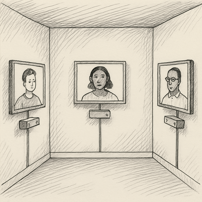
In partnership with the Autism Society of the Regional Municipality of Wood Buffalo, the Five Stories brings voices long absent from public discourse into view. Technology, so often a barrier, will become a bridge, carrying stories across the distance between isolation and engagement.
No single account can contain the full range of human experience. This work gathers many voices in the same space, each remaining distinct and never folded into a single telling. The structure is non-linear and polyphonic, with each story retaining its own pace, tone, and perspective.
The work avoids the familiar arc of beginning, middle and end. Instead, it lingers in small, telling moments — a gesture, a pause, a fragment of speech — that might otherwise pass unnoticed. In these details, the project finds depth and intimacy.
The objective is simple: to create a space where stories are offered freely, received with care and held without judgment. The work is grounded in inclusion, which serves as its truest measure of success.
Roberto partnered with The Autism Society of the Regional Municipality of Wood Buffalo and worked with participants to create the final video installations.
Website: autismrmwb.org
Take Action
Inclusion and accessibility is not about uniformity, it’s about listening to each unique rhythm and pace of being. Here’s how you can take action to effect change.
-
At work: Organizations that embrace inclusion build stronger cultures, boost engagement, and outperform competitors through innovation and empathy. Yet many skilled and educated people with disabilities remain unemployed or underemployed. Gain your competitive advantage, learn how to hire inclusively: Frequently asked questions – ready, willing, and able
-
At school: Embrace neurodiversity through neuro-affirming practices. Instead of trying to make neurodiverse students “fit” neurotypical expectations, celebrate cognitive diversity. Shift from “How do I fix this student’s challenges?” to “How do I design a classroom that values different ways of learning?” Build on strengths, offer multiple ways to participate, honour sensory needs, and recognize behaviour as communication, not defiance.
-
In your community: Support The Autism Society of the RMWB, which advocates for inclusion and provides vital community programming to support caregivers and neurodiverse people, including those with ADHD and other forms of neurodiversity.
-
At home: When you have a disability or are a caregiver of a person with a disability, you will navigate complicated systems, from education, employment to health. To learn how to best advocate for yourself or your loved ones, visit: Self-Advocacy Toolkit | March of Dimes Canada
For more resources on how to support yourself as a neurodivergent person, your dependents, or students visit: Neurodiversity Hub - Resources for Students, Employers & More
Roberto Santaguida
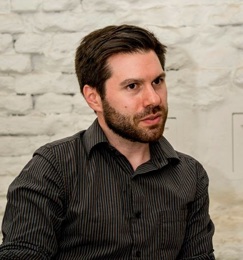
Since completing his studies in film production at Concordia University, Roberto Santaguida’s films and videos have been shown at more than 400 international festivals, including Tampere Film Festival (Finland), CPH: DOX, Copenhagen International Documentary Film Festival (Denmark), Contemporary Art Festival Sesc_Videobrasil (Brazil), Flickers' Rhode Island International Film Festival (United States), transmediale (Germany), and Message to Man (Russia). He has also taken part in artist residencies in numerous countries, including Iran, Romania, Germany, Norway, and Australia. Roberto is the recipient of the K.M. Hunter Artist Award, the Chalmers Arts Fellowship and a fellowship from Akademie Schloss Solitude in Germany. His work grows from an exploratory process, rooted in curiosity and dialogue, centered on lived experience and the voices of others.
Vimeo: https://vimeo.com/184715429 (Santaguida, Roberto. "Goran." Vimeo, uploaded by Roberto Santaguida, Sep 28, 2016)
Untitled
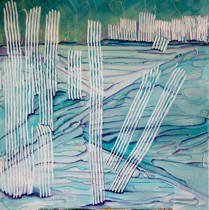
Robyn Rennie’s accessible art installation consists of six 30 X 30 highly textured, mixed media paintings depicting the landscape in Alberta, and more specifically, the Wood Buffalo Region. Each painting is accompanied by a life-size tactile replica for touch. With the intent of inclusivity, Large Print and Braille titles and information will identify the paintings, and audio descriptions of each piece can be accessed by user-friendly audio devices.
Robyn’s work is about experiencing visual art from the point of view of low vision. As an artist with a visual impairment, her work conveys in part how she experiences the world but also challenges popular assumptions about what sight means. Metallic, iridescent, and interference paints provide glimpses into how she experiences the world as even the slightest shift in position creates a new visual experience.
While the intent of this installation is to allow patrons who are blind, or have low vision, to experience her work in the most accessible way possible, being able to explore art through touch adds a deeper dimension for all people to experience.
Robyn's project is aligned with the invaluable services offered by the St. Aidan’s Society & the Canadian National Institute for the Blind (CNIB)
Websites:
St. Aidan’s Society - staidanssociety.ca
Canadian National Institute for the Blind (CNIB) - https://www.cnib.ca/en
Take Action
Accessibility is not an afterthought, it’s an art form of care and imagination, simple actions can make a big positive difference for someone. Here’s how you can take action to effect change.
-
At work: Make your workplace more accessible; simple steps can make a difference. Use large print, alt-text, and clear, simple language in all documents, presentations, and events. Communicate clearly and in multiple ways. For practical guidance visit:Resource Archive - AccessibleEmployers.ca and How-tos- Digital Accessibility Toolkit
-
At school: Support every learner by applying Universal Design for Learning (UDL). Offer multiple ways for students to access information. For learning how to get started with UDL: Universal Design for Learning (UDL)- Digital Accessibility Toolkit
-
In your community: Partner with organizations such as St. Aidan’s Society or the CNIB to learn how to make community spaces more accessible. Follow basic etiquette: ask first before offering help – never assume. Do not touch or move the person’s assistive device; speak directly to the person, not their companion; do not pet a working dog. Notice where access breaks down, the missing ramps, no captions, no quiet spaces, no braille, take action to fix it.
-
At home: Talk openly about disability, access, and inclusion to normalize differences. When planning family outings or events, consider accessibility from the start, not after. Attend workshops, follow creators with disabilities, and challenge your own assumptions regularly.
-
In galleries and museums: Provide large prints, braille, audio descriptions, and tactile replicas whenever possible. Have at least one item available for touch.
Robyn Rennie

Robyn Rennie is a Canadian painter and writer. She achieved a BA in Cultural Studies, with an emphasis in Image and Sound, from Trent University in 2005.
Immediately following graduation, a life-changing vision loss forced Robyn to develop new methods of artistic expression. She employs acrylic grounds and mediums in her work which can potentially evoke an empathic response from observers. Even the slightest shift in position in front of a work creates a new visual experience, embodying how new information can change a person’s point of view.
Robyn’s public art installations are accessible and include Braille. In 2018, the Dunlap Institute used her art in a nation-wide planetarium show for people with visual impairments.
A documentary about Robyn’s work, as well as a workshop with blind children at CNIB’s Lake Joseph Camp that she facilitated in 2024, was created by AMI TV and aired nationally on May 16, 2024.
Website: robynrennie.art
Facebook: @RobynRennieArtist
YouTube: https://www.youtube.com/watch?v=iKdRO_ZEnqw (Rennie, Robyn. "Tactile Art | Our Community (Season 8, Episode 6)." YouTube, uploaded by AMI: Accessible Media Inc., May 17, 2024)
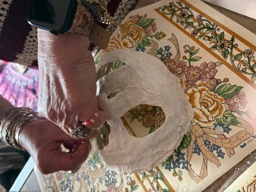
Unmasking, headed by artist Sonia Burke-Smith, addresses challenges and barriers associated with mental healthcare through a multifaceted, artistic approach, incorporating photography, painting, and collage. This project aims to explore the themes of stigma, inequality, grassroots and solutions. Engaging youth through workshops and community storytelling. The installation will feature narratives of individuals who have encountered difficulties with mental health and accessing mental healthcare, highlighting systemic barriers and advocating for enhanced accessibility. The artwork will utilize various methods to visually convey the individual's experiences. The project delves into different themes that are identified as the root causes of mental illness. Mentorship is a significant component through workshops the participants will create photos, essays, fostering, creative expression, and awareness for the community to bring understanding and healing.
Sonia’s project is aligned with E2R Foundation - Global Recovery Community
Website: GRC | Empower 2 Recover
Take Action
Each small act of inclusion builds a safer, more accessible world for everyone. Here’s how you can take action to effect change.
-
At work: Create a workplace where well-being matters as much as performance. You can foster sensory friendly spaces; support balance through evolving approaches to scheduling; workload and work formats; address harassment and microaggressions promptly, using a restorative approach when possible; and lead with trust, compassion and open communication. Learn more about how to create change as an employer: Brandmark of Opening Minds - Mental Health Commission of Canada
-
At school: Encourage open dialogue about emotions to make seeking help a sign of strength, not stigma. Advocate and work for clear guidelines on how to address bullying, harassment and hate incidents in the school environment. Make support easy to find; this looks like clear info, train and supported staff, and visible pathways to get help. For learning more about how to support mental health at school visit: working_together_to_support_mental_health.pdf
-
In your community: Volunteer, advocate, or connect with local organizations such as the Empower2Recover Foundation to ensure veterans and others facing barriers have access to timely, inclusive and culturally sensitive mental health services.
-
At home: Increase your understanding on how to ask for a rightful diagnosis, navigate systems, and push for timely diagnosis and appropriate support. For learning more about how to advocate for yourself and your loved ones visit: Making Mental Health Matter in Alberta: Advocacy Toolkit - Healthy Campus Alberta
Sonia Burke-Smith
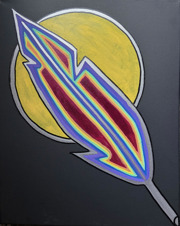
Sonia Burke-Smith is an experienced artist known for her collaborative projects and Public Art installations. She’s dedicated to creating meaningful art that fosters connection, understanding, compassion and healing.
Facebook: @Sister.Sonia
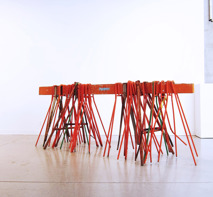
This first iteration of The Barriers Project represents the beginning of an ongoing, collaborative art intervention that will engage artist communities in Canada and beyond. The image of the A-Frame street barrier is one that usually denotes control, access (or lack thereof) and permission and I have chosen these barriers as a symbol to focus on in my work because they represent so much through form, function, and colour, all of which can be manipulated to flip their function and meaning.
The goal of this project is to re-examine, re-contextualize and use this symbol to represent accessibility, inclusiveness and collective agency within third spaces. Local participants strip these objects of their dayglo orange and black colour schemes and reimagine them as objects of welcome and beauty, creating colourful sculptural forms that carry messages of positivity, encouragement or just plain whimsy. This dis-arming of these objects will put the viewer in the position of control, or more gently, co-existence and interaction, liberating the spaces they collectively inhabit, rather than limiting them, drawing attention to issues such as food and home precarity, access to education, clean water, sustainable energy and other issues which are present here in Canada and worldwide.
Steve’s has worked with the Regional Municipality of Wood Buffalo to broaden his reach within the community and gather content and participation in the Barrier Project.
Website: www.rmwb.ca
Take Action
Transformation begins when we choose to create spaces that invite rather than divide. Here’s how you can take action to effect change.
-
At work: Check your physical and digital environments and events for accessibility gaps: ramps, captions, quiet zones, and inclusive signage. Here you can find simple checklist and other resources to help you increase accessibility: Accessibility around the RMWB | Regional Municipality of Wood Buffalo
-
At school: rethink obstacles -physical, social, and emotional- as opportunities for inclusion and connection. Working together, educators, administrators, parents, students, and community leaders help design classrooms that support self-regulation, foster collaboration and peer support, address bullying and discrimination. Create learning spaces where every student feels safe, valued, and empowered to thrive.
-
In your community: Get involved with RACIDE, the Regional Advisory Committee on Inclusion, Diversity & Equity, the Public Art Committee, or the Advisory Committee on Aging and contribute to projects promoting equity and accessibility.
-
At home: Notice where your beliefs or actions might unintentionally create barriers for others- by action or inaction-and reimagine them as opportunities for connection and growth. Ask yourself: Have I ever misjudged or overlooked someone for being different? I feel the least comfortable around people who.... - and why?
Steve deBruyn (he/him)
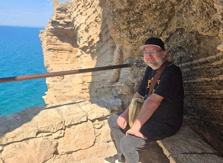
Based in London, Ontario, Steve deBruyn holds a BFA from NSCAD University and an MFA from Western University as well as an Advanced Degree in Landscape Design from Fanshawe College. His practice is typically based in site-specific installation, and he frequently employs carpentry, painting, drawing, and fibre-based sculpture in his work. His education and concurrent career as a landscape professional specializing in sustainable, participatory garden spaces informs his practice and affords a unique perspective to see many connections between the two disciplines and the possibilities that can arise when they come into dialog with each other. Approaching projects with a responsive methodology, deBruyn works in a fluid and improvisational way that fosters improvisation, research and collaboration while also simplifying logistics, environmental impact, and encouraging broad accessibility and community engagement. In 2025 he has shown in London, Ontario, Ruse, Bulgaria, Bath, UK, and Reno, Nevada among other places.
Website: stevedebruyn.ca
Facebook: @SteveDeBruyn
Program Recognition
The Art for Social Change program was initiated by the Public Art Committee and the Regional Advisory Committee on Inclusion, Diversity and Equity and is brought to you by the Regional Municipality of Wood Buffalo (RMWB) in collaboration with Keyano College.
We deeply appreciate the incredible support from social profit organizations whose commitment to reducing barriers is an ongoing and inspiring journey. Thank you for your willingness to collaborate and for recognizing the transformative value that the art brings to social profit advocacy. Together, we are opening doors to meaningful engagement and driving positive change.
“Any form of art is a form of power. It has impact. It can affect change. It can not only move us; it makes us move.” - Raiford Chatman "Ossie" Davis (Award-winning actor, writer, director)
Contact Us
PULSE
Submit a request
Phone: 780-743-7000
Toll free: 1-800-973-9663
Subscribe for RMWB updates
Stay up to date on the services, programs and projects in your neighbourhood!










